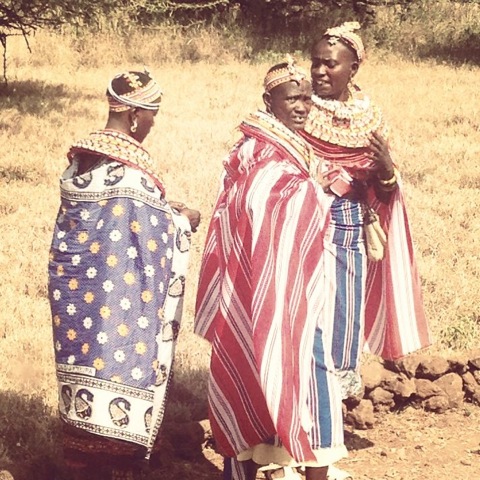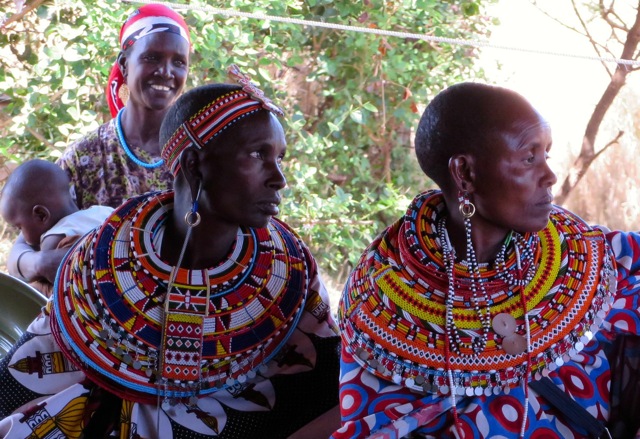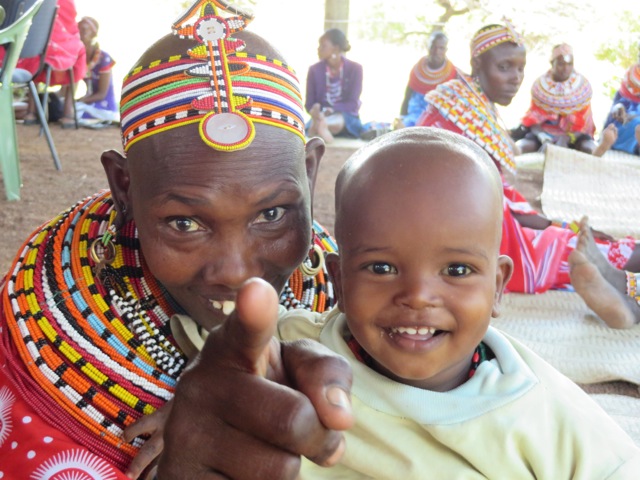Guest Post by Julie Curtis
When I was little, I made gowns out of my bath towels. I tied them over one shoulder and belted them with bathrobe ties. Or I wrapped them around my chest or waist to make a strapless dress or a skirt. Then I would top the whole thing off with an elegant cape-style towel.
The results, it turns out, would have been a lot prettier if I had grown up in Africa and used khangas instead of towels. Khangas are big oversized sarong-y rectangles of lightweight cloth, printed in at least three bright colors with some wild pattern. Some of them even have sayings on them in Swahili that translate roughly into fortune cookie prophecies, like “you gossip about everything” and “you have not yet met the person who will tell you what you need to know.”
Women here use these things for skirts, tops, headdresses, capes, baby slings, totebags—I’ve even seen one used to hold a goat between two people on a motorcycle. Somehow, no matter how many khangas it takes to make an outfit, and no matter what strange combination they’re in, they always look perfect together.
So as the matatus pull up in the dirt parking lot behind the bead shop and the doors open, the Samburu women descend like a flock of tropical birds, their kangas floating behind them as they pick their way across the pebbly rust-red gravel in their delicate plastic shoes. I have to give it to them. Their designs are better than anything I ever came up with in the bathroom. But the big edge these women have over me in my terry cloth fashion creations is their flair with accessories.
They’re wearing massive multi-pieced collars that cover them in rings of beaded rainbows from neck to mid shoulder, and coordinating headdresses. Most of them have cuff-style ankle bracelets made of silver or more beads. Some are wearing heavy earrings that make windows in their earlobes, with ropes of beads attached between them, suspended under the woman’s chin. Maybe there’s even a beaded purse hanging from that. One woman’s headband holds a curtain of red beads across her face, almost hiding some serious facial deformation. I’m told she was attacked by a crocodile when she was a child.
This is Samburu business attire. These women have come to renegotiate the prices they are paid for the bracelets, necklaces, coasters, baskets, key chains and holiday ornaments they make out of wire and beads to supplement their family livestock herding income.
They are checking me out from head to toe. My pathetically weak, white skin that keeps wrinkling and spotting no matter how many cosmetics I layer on. My hair, rebellious in this blow-dryerless environment, even though I had a Brazilian Blowout last month. My rolled up and snapped safari pants (which are actually French, thank you very much.) My clunky khaki-gray leather sandals, the kind that would survive a capsize in a river raft. I tried to find the cutest ones I could, but they still make my feet look like baby elephants. I can see it in their eyes as they discuss me behind their hands. I laugh, knowing they’re talking about me. They laugh in return, knowing they’ve been busted.
I walk over to them and ask if they speak English. They shake their heads. I point to their necklaces. “Supak!” I say. This is the only word I know in the Samburu language. It means beautiful. Their embarrassed scowls instantly turn to humble smiles. And there it is. Our common ground. All women want to be beautiful.




Julie: I enjoyed your well written post. Hopefully it wasn’t a painful editing process.
Amen. All women want to be beautiful. Love this. Thanks for sharing!
Loving your posts, Julie. Wonderful, lyrical, poignant and relatable. Can’t wait to hear the other stories when you get home! Miss you, fly safe. xo
Great photos and and stories, Julie. So awesome you’re able to be out there and share in the experience! -Robin
Julie, great effort, see you at home.. Cap Dino